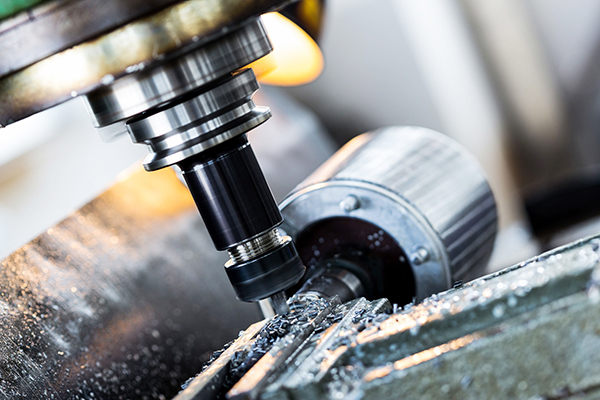The difficulties of stainless steel material processing mainly include the following aspects:
- High cutting force and high cutting temperature
This type of material has large strength and large plastic deformation during cutting, so the cutting force is large. In addition, due to the poor thermal conductivity of the material, the cutting temperature is increased, and the high temperature is often concentrated in the narrow area near the cutting edge, which accelerates the tool wear.
- Severe work hardening
Austenite stainless steel and some high temperature alloy stainless steel are Austenite structure. These materials tend to be hardened when machined, often several times as much as plain carbon steel. The cutter is cut in the hardened area to shorten the tool life.
- Easy to stick the tool
Both Austenite stainless steel and Martensite stainless steel have the characteristics of strong and tough chip and high cutting temperature. When the strong and tough chip flow through the front surface of the cutter, the phenomenon of bonding, welding and other adhesion will occur, affecting the surface roughness of the processed parts.
- Tool wear is accelerated
The above materials generally contain high melting point elements, large plasticity and high cutting temperature, which make the tool wear faster and the tool wear and change frequently, thus affecting the production efficiency and increasing the tool use cost.
The processing technology of stainless steel parts
Through analysis of the difficulties in the above processing, the processing technology of stainless steel and the design of relevant tool parameters should be greatly different from that of common structural steel materials, and the specific processing technology is as follows:
1. Drilling
When drilling, due to the poor thermal conductivity of stainless steel materials, small elastic modulus, hole processing is also more difficult. To solve the problem of hole machining of this kind of material, it is mainly to choose suitable tool material.
2. Boring machining
(1) selection of cutter materials
Due to the high cutting force and cutting temperature when processing stainless steel parts, the material of the cutter should be selected as high as possible, with good thermal conductivity of cemented carbide.
CBN (cubic boron nitride) blade can be used for quenching parts. CBN is second only to diamond in hardness, reaching 7000 ~ 8000HV. So the wear resistance is very high, compared with diamond, CBN prominent advantages is the heat resistance is much taller than diamond, up to 1200 ℃, can withstand high cutting temperature. In addition to its chemical inertness is very big, with iron group metals during 1200 ~ 1300 ℃ doesn’t chemistry, therefore very suitable for processing stainless steel materials. Its tool’s life is several dozen times that of carbide or ceramic tool.
(2) geometric parameters of cutter
The geometrical parameters of the cutter play an important role in cutting performance. In order to make cutting fast and smooth, the carbide tool should adopt a larger rake angle to improve the tool life. Generally when rough machining, rake angle can be selected10 ° ~ 20 °; Semi-finishing, rake angle can be selected 15 ° ~ 20 ° ; Before finishing, rake angle can be selected 20 ° to 30 °. Is based on the choice of the angle, when the process system good rigidity, can be selected 30 ° to 45 °; Such as process system rigidity is poor, the rake angle can be selected 60 ~ 75 °, when the workpiece when the ratio of length to diameter of more than 10 times, the rake angle can be selected 90 °.
(3) the roughness value of front blade grinding is small
In order to avoid the phenomenon of chip stick cutter, the front and back blade of the cutter should be carefully grinded to ensure a small roughness value, so as to reduce the resistance of chip and avoid chip stick cutter.
(4) the cutting edge should be kept sharp
Cutting edge should be kept sharp to reduce work hardening, feed and back feed should not be too small to prevent cutting in the hardening layer, affecting tool life. The cutting edge can be repaired by drill bit grinding machine.
(5) pay attention to grinding of chip breaker
Due to the strong and ductile character of stainless steel chips, the tool face should be ground properly on the chip breaker, which makes the cutting process easy to interrupt chip, host chip and discharge chip.
(6) selection of cutting dosage
According to the characteristics of stainless steel materials, choose low speed and large amount of feed.
(7) the selection of cutting fluid should be appropriate
Because stainless steel has the characteristic that produces easily bond and heat dissipation bad, so choosing anti-bond and heat dissipation good cutting liquid phase is important in boring. For example, if the cutting fluid with higher chlorine content is selected, and the aqueous solution without mineral oil or sulfites with good cooling, cleaning, rust prevention and lubrication, such as h1l-2 synthetic cutting fluid.
By using the method can overcome the above process of stainless steel processing difficulties, make the stainless steel during drilling, reaming, boring tool life been improved greatly, and reduce the operation knife and tool change in the number of times to raise the production efficiency and machining quality, reduce labor intensity and production cost, can obtain a satisfactory result.


